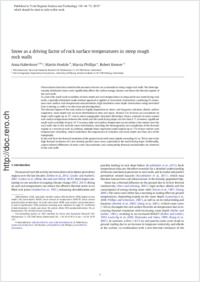Snow as a driving factor of rock surface temperatures in steep rough rock walls
- Haberkorn, Anna WSL Institute for Snow and Avalanche Research SLF, Davos, Switzerland - Unit of Geography, Department of Geosciences , University of Fribourg, Switzerland
- Hoelzle, Martin Unit of Geography, Department of Geosciences , University of Fribourg, Switzerland
- Phillips, Marcia WSL Institute for Snow and Avalanche Research SLF, Davos, Switzerland
- Kenner, Robert WSL Institute for Snow and Avalanche Research SLF, Davos, Switzerland
-
26.06.2015
Published in:
- Cold Regions Science and Technology. - 2015, vol. 118, p. 64–75
English
Observations show that considerable amounts of snow can accumulate in steep, rough rock walls. The heterogeneously distributed snow cover significantly affects the surface energy balance and hence the thermal regime of the rock walls.To assess the small-scale variability of snow depth and rock temperatures in steep north and south facing rock walls, a spatially distributed multi-method approach is applied at Gemsstock, Switzerland, combining 35 continuous near-surface rock temperature measurements, high resolution snow depth observations using terrestrial laser scanning, as well as in-situ snow pit investigations.The thermal regime of the rock surface is highly dependent on short- and longwave radiation, albedo, surface roughness, snow depth and on snow distribution in time and space. Around 2 m of snow can accumulate on slopes with angles up to 75°, due to micro-topographic structures like ledges. Hence, contrasts in mean annual rock surface temperature between the north and the south facing slopes are less than 4 °C. However, significant small-scale variability of up to 10 °C in mean daily rock surface temperature occurs within a few metres over the rock walls due to the variable snow distribution, revealing the heterogeneity and complexity of the thermal regime at a very local scale. In addition, multiple linear regression could explain up to 77% of near‐surface rock temperature variability, which underlines the importance of radiation and snow depth and thus also of the topography.In the rock faces the thermal insulation of the ground starts with snow depths exceeding 0.2 m. This is due to the high thermal resistance of a less densely packed snow cover, especially in the north facing slope. Additionally, aspect induced differences of snow cover characteristics and consequently thermal conductivities are observed in the rock walls.
- Faculty
- Faculté des sciences et de médecine
- Department
- Département de Géosciences
- Language
-
- English
- Classification
- Earth sciences
- License
-
License undefined
- Identifiers
-
- RERO DOC 257199
- DOI 10.1016/j.coldregions.2015.06.013
- Persistent URL
- https://folia.unifr.ch/unifr/documents/304504
Statistics
Document views: 130
File downloads:
- pdf: 333
